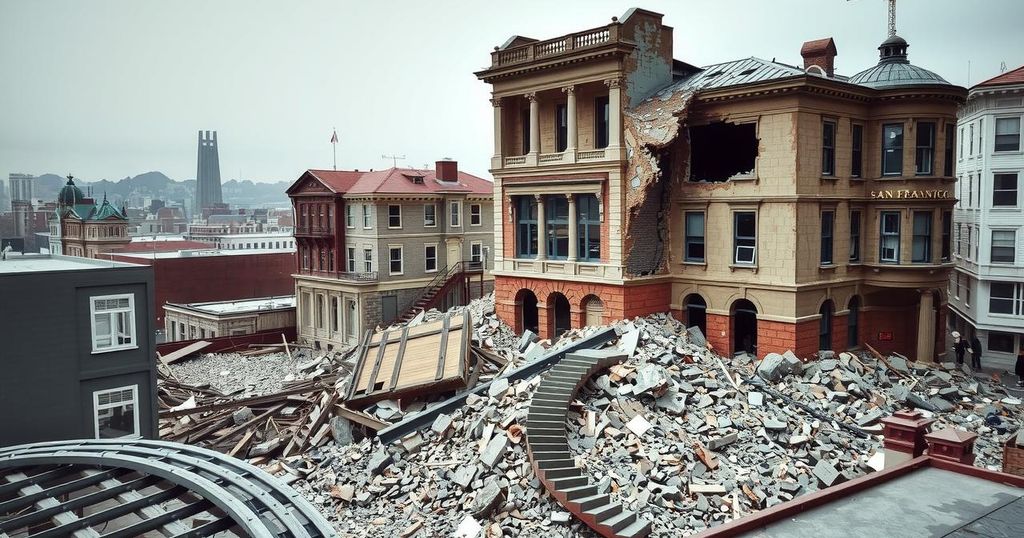World news
AMERICAS, ASIA, BRITANNICA, CALIFORNIA, CHINA, CHINATOWN, CITY HALL, COOS BAY, EMERGENCY RESPONSE, EUROPE, EVACUATIONS, FRANCISCO, GOLDEN GATE PARK, HUMBOLDT, HUMBOLDT COUNTY, JAPAN, LOS ANGELES, MARKET DISTRICT, MEXICO, MONTGOMERY STREET, NATURAL DISASTER, NATURAL DISASTERS, NORTH AMERICA, NORTH BEACH, OLD CITY, OREGON, PALACE HOTEL, PARAGUAY, PHILIPPINES, RUSSIAN HILL, SALINAS, SAN ANDREAS, SAN ANDREAS FAULT, SAN BENITO, SAN FRANCISCO, SAN JOSE, SAN JUAN BAUTISTA, SANTA ROSA, SOUTH AMERICA, SOUTH OF MARKET, TELEGRAPH HILL, UNITED STATES
Ethan Kumar
0 Comments
The Devastating Impact of the 1906 San Francisco Earthquake
On April 18, 1906, a powerful 7.9 magnitude earthquake devastated San Francisco. The quake and subsequent fires destroyed over 28,000 buildings, leaving more than 3,000 people dead and 250,000 homeless. The city undertook significant reconstruction efforts, leading to improved building standards and urban planning. This disaster also spurred advancements in geological sciences, particularly in earthquake mechanics.
The San Francisco earthquake of 1906, which struck at 5:12 AM on April 18, was a devastating event with a magnitude of 7.9. It originated along a 270-mile stretch of the San Andreas Fault, affecting areas from San Juan Bautista to Humboldt County. The quake reverberated from Los Angeles to Coos Bay, Oregon, causing unprecedented destruction in San Francisco and neighboring towns, including San Jose and Santa Rosa.
Prior earthquakes had struck the city in 1864, 1898, and 1900, but none matched the intensity of the 1906 disaster. The seismic event was accompanied by a terrifying roar likened to “the roar of 10,000 lions,” as the city was shaken violently, halting cable cars and shattering buildings. The aftermath saw extensive fires ignite, exacerbating the destruction, as flames consumed four square miles of the city over four days, demolishing approximately 28,000 structures and leading to an estimated $350 million in damages.
The initial death toll was thought to be around 700; however, it is now believed that over 3,000 lives were lost. Approximately 250,000 residents were left homeless, many seeking refuge in Golden Gate Park or traveling to nearby communities. In response to the crisis, relief efforts brought food and clothing, while financial contributions poured in from across the globe, aiding the recovery process. Although insurance claims totaled around $300 million, local resilience played a crucial role in the city’s reconstruction.
Significant steps were taken to rebuild San Francisco with enhanced earthquake and fire-resilient structures. Urban planning efforts proceeded as the remnants of the old city were cleared, leading to a promising resurgence. In 1915, San Francisco showcased its recovery efforts during the Panama-Pacific International Exposition. This calamity led to geological studies that contributed to the development of the elastic rebound theory, explaining the mechanics of earthquakes.
The 1906 San Francisco earthquake is among the most significant seismic events in American history. Understanding its impact involves an analysis of its geological origins, historical quirks, and subsequent socio-economic repercussions. The earthquake not only caused immediate destruction but also catalyzed advancements in urban planning and emergency management protocols in seismically active regions. It is essential to appreciate the context of past seismic events to assess the severity of the 1906 quake accurately.
The 1906 San Francisco earthquake remains a pivotal moment in California’s history, marked by an extraordinary devastation that reshaped not only the physical landscape of the city but also its societal fabric. With thousands of lives lost and extensive property damage, the event underscored the need for better urban resilience. The lessons learned from this disaster fostered innovations that continue to enhance earthquake preparedness and response strategies to this day.
Original Source: www.britannica.com




Post Comment